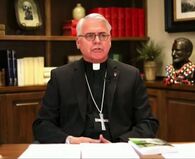Switching to solar energy also has great potential for creating jobs. I want to share with you how many workers it took to “keep my light bulbs lit.” (Note: This list does not include those who made the solar panels, wiring, or "inverter." --Solar generates DC electric; households typically use AC. An inverter changes the DC to AC.)
 Panels on author's lawn. Photograph by author.
Panels on author's lawn. Photograph by author. 
Six installers erected the framework and installed the solar panels. Two electricians installed the inverter, ran the wiring from the array of panels, connected the converter to the electrical meter, and mounted meters that measured the kWh the system produced and the amount of carbon that was saved.
Our utility company, Metropolitan Edison (Met-Ed), provided a meter that can run backwards so that excess energy the panels produce can go to the grid. Because energy was going to the grid, the solar company I used created an LLC in our names as an electric generation company. The LLC gets funds via the Alternative Energy Credit (AEC). Electric utilities are required to purchase alternative energy. The energy we create with our system is sold in 1000 kWh increments to utilities. The credit has ranged from 10 to 50 dollars per unit.
Finally, a township inspector checked the work at several stages. The maintenance-free galvanized steel support posts holding up the framework the panels are on are required to be a certain depth, and, with the panels on it, must withstand winds of 200 mph. The inspector also had to sign off on compliance with electrical codes. For this implementation, the inspector was especially helpful in that he offered excellent solutions to problems the installers encountered. For example, rock limited the depth of the posts. To compensate for this, he advised the installers to increase the number of posts. Problem solved. The inspector was the final worker involved with the system.
After setting everything up, using solar energy has been simple. On August 8, 2010, our system began generating electricity. Once a year we report the wattage the system generated to the company from whom we purchased the system. This is used to calculate the AEC and make sure the system is running efficiently. Other than that, there is no maintenance. Even the snow simply falls off it in the winter. After birds are done nesting under it, I trim any brush, weeds, or grass that grow there.
Some of the critics claim that solar is undependable. It only generates electricity when the sun is shining. That’s true. But solar energy can be stored in batteries like those produced by Tesla. When not generating power, I draw from the grid, paying for the energy I get from the grid.
My experience has only been positive. What’s more, it has been productive. As of March 25, 2021, the sun shining on our side yard has generated 122,838 kWh (Note: meter count flipped over 99999 much like a car’s odometer– there is a 1 in front of the 22838 in the photograph). That’s 122,838 kWhs I didn’t have to buy from our electric utility company. As important, or even more so, our system reduced our carbon-footprint by 209,872 lbs or 104 tons, 4 tons more than the 100-ton capacity coal car I unloaded at the Reading Railroad (see blog part 1 from April 25).
As system costs go down and panels become even more efficient, solar energy is becoming more and more desirable and practical. As a solution to global climate change, it has become essential. With governmental support at the federal (The Green New Deal) and state levels like Governor Wolf’s initiatives in Pennsylvania, solar energy has joined other forms of energy such as wind and tidal in the toolbox we have to counter climate change (Tidal energy is a renewable energy powered by the natural rise and fall of ocean tides and currents. Some of these technologies include turbines and paddles).
With the critical challenge of climate change, we need to shine light on all the tools we can.

























 RSS Feed
RSS Feed